Clinical Practice Using Classical Acupuncture Manipulation Techniques and Electro Acupuncture: A Survey of Practitioners in Australia
* Weihong Li;
-
* Weihong Li: Department of Chinese Medicine, University of Technology Sydney, Sydney, Australia.
-
Oct 25, 2022 |
-
Volume: 3 |
-
Issue: 4 |
-
Views: 3215 |
-
Downloads: 1845 |
Abstract
Objectives: Despite the current prevalence of Electroacupuncture in the world, the information comparing Electroacupuncture to classical acupuncture manipulation techniques is very limited, and the indications for using Electroacupuncture and classical acupuncture manipulation are very limited techniques are absent for practitioners and educators to follow. This study aims to identify how these two acupuncture-related modalities are applied in Australia and the reasons.
Design and setting: A 17-item survey, designed to collect information pertaining to acupuncture practicing modality, was distributed to Chinese medicine practitioners in Australia by email, hardcopy, and online survey (Survey Monkey) from June 2015 till June 2016.
Results: Of the respondents, 78.7% had achieved a bachelor’s degree, nearly half have practiced for over 16 years, and 64% cared about mindfulness, reflecting the overall professional background and experience in understanding acupuncture. 80% of respondents think that classical acupuncture manipulation techniques should be used theoretically in all or most acupuncture treatments considering “practitioners are shifting into greater awareness and presence, techniques are more precise/flexible with better clinical results,” even though classical acupuncture manipulation techniques are thought of as “too strong/unpleasant sensation, causing patients’ complaints” and “time-consuming, and it is hard to treat multiple patients at the same time for practitioners.” Some practitioners also accept Electroacupuncture, especially for muscular-skeletal problems, because it is regarded as “working well and easy to administer,” even though knowledge of the selection of specific intensity, frequency, and pulse wave was insufficient.
Conclusions: Classical acupuncture manipulation techniques achieved miraculous results, especially when Chinese medicine Qi and blood theory and pattern differentiation are concerned. Electroacupuncture should be applied properly with better understanding and necessary cautions, whether used in research or clinically.
Introduction
Electroacupuncture (EA) is an innovative acupuncture therapy in which, after the needles are manually and properly inserted into certain points. Then, they are connected to an electric stimulator. Since the stimulating parameters, such as the frequency, wave, and intensity, are settable and adjustable, the actual stimulation applied to the body can be easily standardized and changed [1,2].
EA has introduced to China over 100 years ago, and ever since, it has become more and more popular [3]. However, the systematic research work on EA in China started about 60 years ago. Studies revealed that two stimulation modalities, classical Manual Acupuncture (MA) and EA, work under different mechanisms [4–9], and EA shows superiority over MA in most scenarios [2,10–19], in particular for the relief of pain [5,10,18]. Moreover, since its stimulating parameters can be set quantitatively, EA is irreplaceable in modern acupuncture research.
However, students are taught to practice traditional acupuncture manipulation techniques from the first day of studying acupuncture in China, starting from locating acupoints, inserting needles, applying fundamental and more complex manipulation techniques for De Qi, using reinforcing and reducing techniques, and then withdrawing needles to complete the whole acupuncture procedure. Acupuncture is regarded as a unique subject, integrating knowledge and hand skill together [20]. These two components, equally important, are complementary and dependent on each other.
EA was strongly discouraged in the 1990s when I was a university student, particularly when I followed several mentors, including Prof. Puren He, for my mentoring training in China. As a result, when I left Beijing, China, in 2000, there were very few acupuncture clinics and hospitals where EA was applied. However, by 2014, when I went back to Beijing, EA was much more widely accepted and applied in acupuncture clinics.
As a clinical practitioner and lecturer who has practiced and taught traditional acupuncture manipulation techniques and electroacupuncture for 27 years, I have been confused about which modality practitioners should use in clinical scenarios and how to integrate two of them properly, given that EA is relatively new. In addition, the research/publications comparing MA and EA are very limited. So in 2015, I started my research work using a survey to identify how these two acupuncture-related modalities are applied in Australia and the reasons.
Material and Methods
Design: A 17-item survey (Appendix A) containing common clinical questions aims to identify how and why classical acupuncture needle manipulation and EA are applied in Australia. It was designed and prepared bilingually, trying to recruit more respondents, and then distributed to Chinese medicine practitioners in Australia following ethics approval from the Human Research Ethics Committee of the University of Technology Sydney (UTS HREC 2015000402).
Recruitment and participants: Firstly, 50 surveys were sent out in hardcopy in June 2015, followed by direct email and online surveys (SurveyMonkey). By 30 June 2016, there were 4,762 Chinese medicine practitioners registered in Australia, of which a total of 126 practitioners completed this survey by December 2016. Not all respondents completed all seventeen questions, and there were skipped questions in some responses, which explains the incongruence of the number of respondents in questions. Most respondents replied in either Chinese or English language; however, some did in both Chinese and English. It is not surprising that the response rate is low, and the possible reasons for this are classical acupuncture manipulation techniques were not correctly taught in Chinese Medicine education institution, especially overseas, due to short education history and limited educational resources, and many practitioners do not even know it at all. EA is also not popularly used in Australia, and practitioners who knew both MA and EA well enough and were interested in participating in this survey are few. This also explains why some respondents failed to answer all questions in their responses to the survey.
Analysis: This study conducted descriptive statistics on the number and percentage.
Results
Questions 1 and 2 (about respondents): The qualification of 142 respondents was classified into 4 degrees, starting from none to diploma (advanced diploma), bachelor, and postgraduate. For each degree, I gave two primary fields of acupuncture or Chinese medicine. (Figure 1) shows that most respondents held a bachelor’s degree in Chinese medicine (n = 48; 41.7%), followed by a bachelor’s degree in acupuncture (n = 37; 32%). It is not surprising that most respondents (n = 85; 78.7%) achieved bachelor’s degrees. To the question of the language used in achieving their degree, the responding rate was very low, and only 48 out of 59 respondents replied that the degree course was delivered in non-Chinese language, while 11 replied that it was delivered in Chinese.

With respect to the duration of practice, over one third of 119 respondents (n = 46; 38.7%) had a relatively short period (5 years–15 years), followed by long (26 years–39 years; n = 26; 21.9%) and medium (16 years–25 years; n = 24; 20%) period. It is delighted to see in (Figure 2) that nearly half of respondents (n = 54; 46%) have practiced for over 16 years, so presuming to have a thorough understanding of acupuncture.

Question 3: Even though Tiao Shen (mindfulness or focus) has never been a hot topic in both acupuncture education and research, 99% (n = 99) of 100 respondents answered “yes” in their reply, and 64% (n = 64) of them care about Tiao Shen.
Question 4: Answers were received in English and Chinese, involving both Chinese and western medicine terms; some respondents gave more than one answer. The results are summarized and displayed in (Table 1).
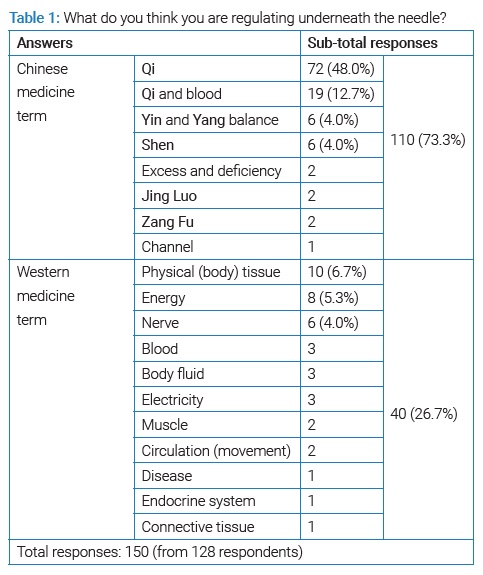
Question 5: Regardless of the actual practice, when asked whether classical acupuncture manipulation techniques can be replaced by electroacupuncture, approximately 50% (n = 50) replied: “not at all,” followed by “less than half time” (n = 30; 30%). Together, the results indicate that 80% of 101 respondents think that classical acupuncture manipulation techniques should be used theoretically in all or most acupuncture practices.
Question 6: In terms of the indications that electro acupuncture may be applied to replace classical acupuncture manipulation techniques, muscular skeletal related problems (n = 41; 37.3%) was selected as the most popular condition, followed by stroke (n = 12; 10.9%), labour induction (n = 10; 9.1%) and sciatica (n = 6; 5.5%). Qi and blood stagnation was the most common (n = 7; 23.3%) Chinese medicine pattern identified. (Table 2) also shows that over two thirds of responses (n = 110; 78.6%) were given based on western medicine diagnoses (disease, sign or symptom).
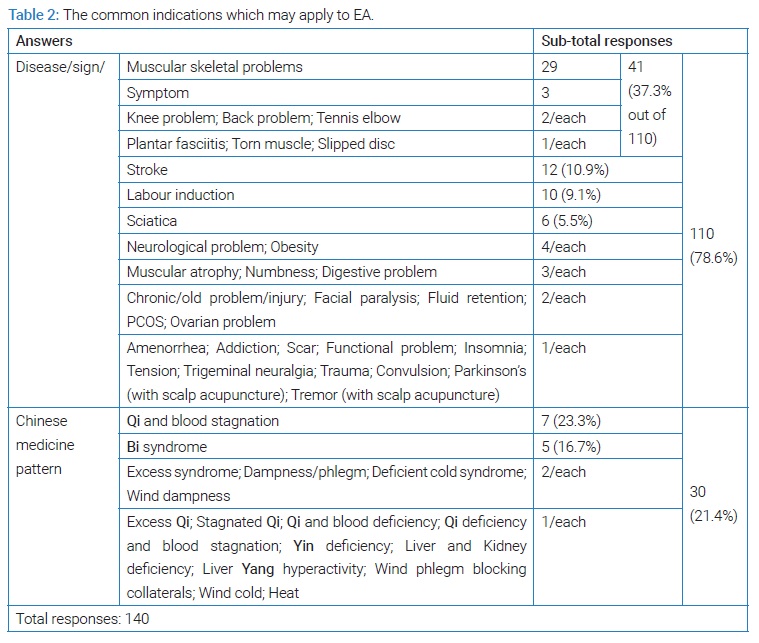
Question 7 and 8: Answers to question 7 reflected similar situations to question 5 that only 14% (n = 17) of respondents use electroacupuncture in most of their treatments. When respondents, who used electroacupuncture as the main modality in most of their treatment, were asked to give reasons in question 8, (Table 3) shows that 15 of 43 responses (34.9%) thought that electroacupuncture works well, while a smaller number reported that electroacupuncture is easy to administer (n = 11; 25.6%). Some respondents selected more than one reason, and this is understandable.
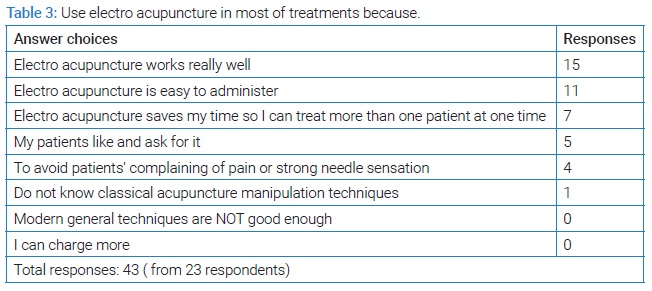
Question 9, 10, 11, and 12: Regarding the management of electroacupuncture stimulators, over 68% (n = 13) of respondents replied that they carefully set up the parameters when using electroacupuncture. However, the responses concerning what helps them select a certain intensity, frequency, and pulse wave, were absent (Table 4).
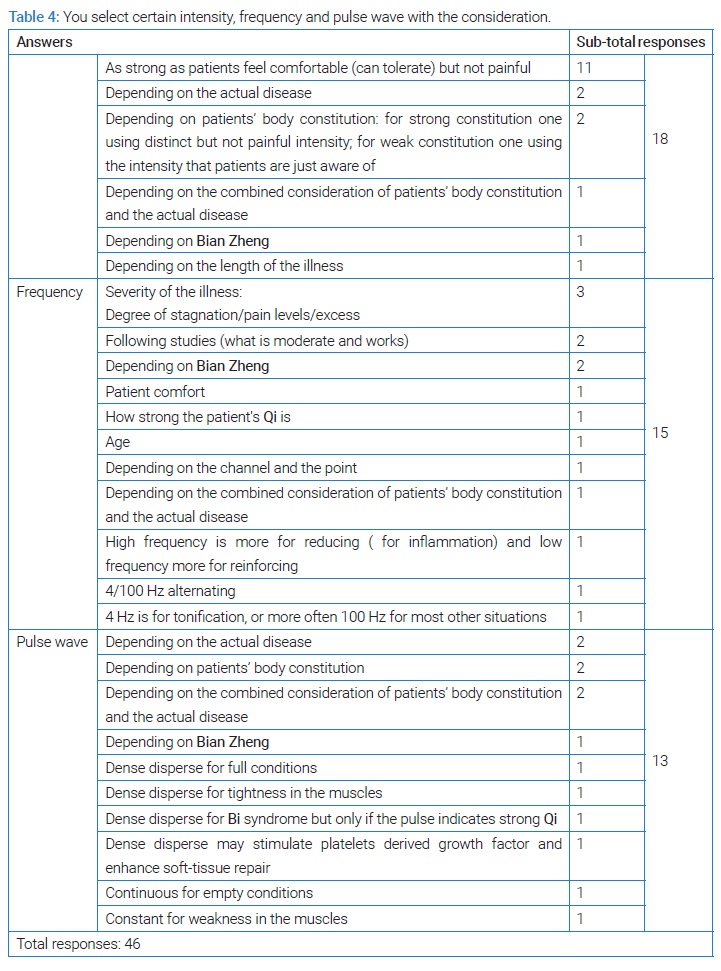
Question 13 and 14: Although most of the respondents (n = 104; 86%) did not choose EA in question 7, it does not mean they solely applied classical acupuncture manipulation techniques. Actually, only 77 out of 108 (71.3%) respondents in question 13 chose classical acupuncture manipulation techniques, while 31 did not. Besides classical acupuncture manipulation techniques and EA, there is a modern technique (simplified classical acupuncture manipulation technique) characterized by direct needle insertion, absent or mild needle manipulation, needle retention, and then needle withdrawal. Therefore, this technique applies neither complicated classical techniques nor electric stimulation. Responses to question 14 indicate many practitioners use this simplified technique due to 5 different reasons, as shown in (Table 5), and the main one (n = 21; 38.2%) was reported in patients complaining of pain or strong needle sensation arising from classical acupuncture manipulation techniques.

Question 15: Half of the respondents (n = 11) who do not use electroacupuncture replied that they do not know electroacupuncture very well, and another half (n = 11) thought electroacupuncture does not work well.
Question 16: All answers from the respondents are summarized into 19 categories and displayed in (Table 6). Obviously, a good clinical effect was considered to be the main advantage (n = 42; 69%) of classical acupuncture manipulation techniques.
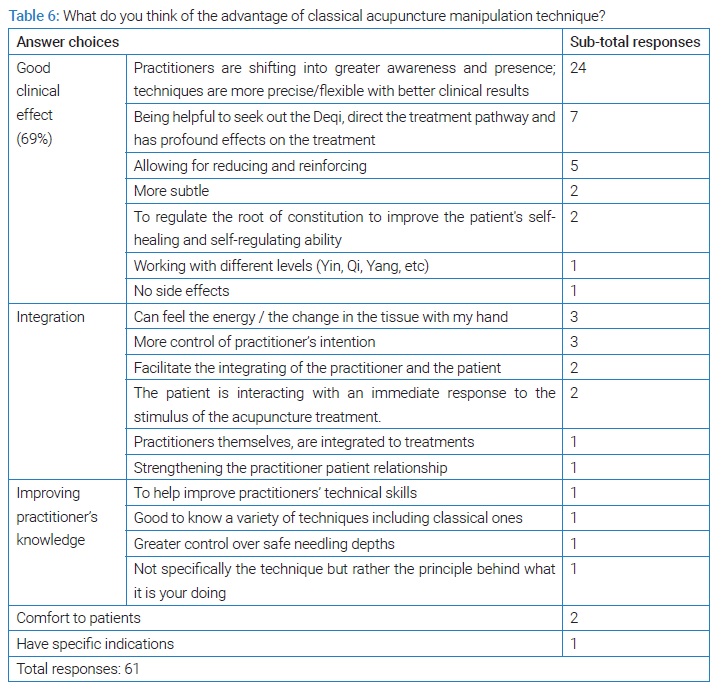
Question 17: (Table 7) displays 54 responses in 13 categories, of which strong/unpleasant sensation (31%, n = 17) and time consumption (30%, n = 16) are two main disadvantages of classical acupuncture manipulation techniques.
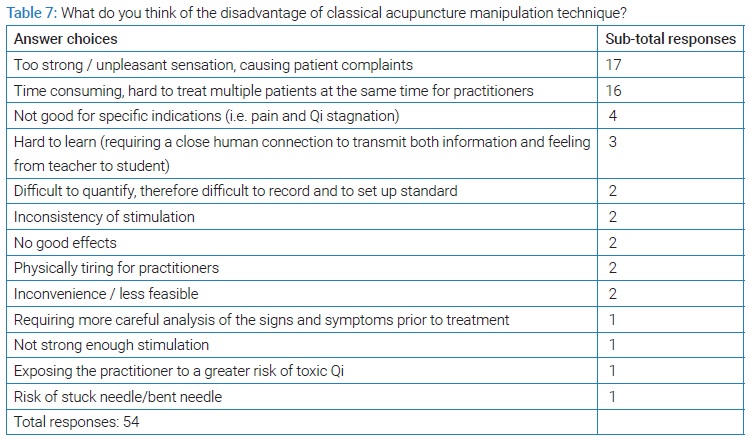
More comments and opinions: Other comments and opinions that respondents left at the end of the survey are listed in (Appendix B).
Discussion
Applying Tiao Shen (simply understood as mindfulness or focus) during acupuncture treatment: Shen is an essential and very common term in Chinese medicine; it can be translated into many different words, such as mind, spirit, consciousness, soul, vitality, energy, etc. In Yellow Emperor’s Inner Cano, Shen was mentioned over a hundred times, mainly when acupuncture and the needling technique were discussed. The word Shen is usually used in combination with other words, for instance, Zhi Shen (cure/manage Shen), Tiao Shen (regulate Shen), Shou Shen (hold/keep Shen), Ben Yu Shen (focus/based on Shen), which can be understood differently by different individuals and in different scenarios [21]. Basic Questions emphasizes that all needling techniques must start with Shen in two descriptions. Spiritual Pivot also described inferior doctors focusing on practitioner’s external hand techniques only, while superior doctors care for internal Shen (when applying needling techniques). In the textbook Acupuncture and Moxibustion Techniques, Tiao Shen and De Qi (obtaining Qi) are taught separately as special topics following the section on acupuncture techniques. Therefore, it also reflects the importance of Shen to hand techniques and the mutual relationship between Shen and De Qi [22]. Tiao Shen and needling techniques are regarded as two essential means by which good results can be adequately achieved and quickly [23–25].
Although Shen takes such an important role in the whole acupuncture treatment procedure, it has been overlooked for a long time in both Chinese medicine clinics and education.
Only 112 papers published in the Chinese language and two papers in English were found from 1979 to 2022, during which no proper clinical trial can be located. In comparison, De Qi receives much more attention in a clinic, research and education. Therefore, Tiao Shen was discussed firstly in this survey before all other questions were asked. The answer of whether to apply Tiao Shen partly reflects practitioners’ understanding of the mechanism of acupuncture and relates to the treatment modality they choose and how they treat needles with their hands in actual practice.
MA versus EA
Working mechanisms involved: To date, only a few studies have attempted to compare the underlining mechanism induced by MA and EA, and this limited research demonstrates that different brain networks are involved during MA and EA stimulation [26,27] which act different nerve conduction pathways, neuro-transmitters and the mechanoreceptors [28], possibly affect different immune molecules. Thus MA and EA might have treatment potentials for specific disorders [29,30].
Clinical application of EA versus MA: In 2010, three acupuncture practitioners from Beijing surveyed clinical practitioners, and they tried to find out how popular and acceptable EA was in clinical practice [2]. The outcome analysis indicated that EA was widely used in acupuncture treatment to replace MA. However, there was no clear agreement on whether EA could replace MA or not. Very few practitioners think EA can replace MA, while most of them believe that EA can only replace MA in certain cases because hand techniques have their unique functions in treatment. Regarding the proper indications of EA, this survey suggested stroke, muscle atrophy, painful syndrome, Bell’s palsy, and obesity, which are brain and neurological system problems. In addition, general pain and various functional disorders were also included. This study concluded that EA has advantages only in repairing brain and neurological tissue, reducing pain, and regulating functional disturbances. Furthermore, EA does not work as effectively as MA in certain kinds of cases [31–34], and there are even some contraindications reported [35]. Therefore, EA needs to be used with precautions and caution; however, these seem to be neglected in most research studies and clinics.
Pattern differentiation and treatment: Bian Zheng Lun Zhi, which means pattern differentiation and treatment, is the fundamental characteristic of traditional Chinese medicine (TCM). Bian Zheng is a unique procedure in the TCM diagnosis, and it includes summarizing the patient’s constitution, determining the etiology, location, nature, etc., of the problems happening in each body over a certain time. Lun Zhi means treatment, indicating the precisely prescribed treatment based on a ready-made understanding of the problem, for example, acupuncture prescription specifying points and hand techniques, possibly including moxibustion, cupping therapy, bloodletting therapy, etc. Pattern differentiation and treatment are unique since it is very different from the conventional western medicine (WM) diagnostic procedure, which tries to find out the name of a particular disease with the help of different tests. Then the same treatment is given to almost everyone who shares the same disease, without paying much attention to the differences between the individuals. However, patients with the same WM disease may receive different acupuncture points, and hand techniques due to their different patterns, and one patient can be given different points and hand techniques over different treatment sessions because the patterns may change with time. Only when you apply acupuncture points and techniques following the proper pattern differentiation can you possibly achieve good results. In the case of very experienced practitioners, they can detect even minimal changes in patients by touching needles with their hands and then instantly adjusting the hand manipulations accordingly.
By contrast, the released stimulation from EA is also adjustable for different patients with different disorders, the parameter is an essential factor that influences the effect of EA [36], and most practitioners were reported to select the parameters carefully in this survey.
The precision of stimulating parameter in EA and Innovative acupuncture apparatus: Investigation of the precision of stimulating parameter in EA has been popular in the last several decades in both China and overseas, but the clinical and laboratory efficacy demonstrated by using specific parameters were only limited to certain patients and the healthy human body. Some results suggested that functional activities of certain brain areas might be correlated with EA-induced analgesia in a frequency-dependent dynamic. EA-induced analgesia with low and high frequencies seems mediated by different brain networks, though overlapped [27,30,37]. Research in 2018 suggested EA parameters need to be quantified to provide a universal and objective standard for experimental studies, more important, to offer theoretical evidence to select the optimal parameters for clinical practice [38]. Another research published in 2015 found out that different parameters produce different effects on the body, but only in the experimental field, not in a real clinic.
Moreover, most researchers focused on single factor study, leading to a lack of understanding of parameters’ combination effect [30,39]. For example, regarding TCM pattern and EA parameters, low frequency and mild stimulation have been suggested for a deficiency pattern, and high frequency and intense stimulation for the excess syndrome. However, one research revealed the reverse [11]. Therefore, clear scientific standards on setting up the parameters for different kinds of diseases, for the same disease in different stages, particularly for different TCM patterns and clinical environments, are still missing [35].
Fortunately, some people have been thinking about these problems, issues, and solutions regarding the application of EA, and they tried to combine traditional acupuncture with modern instruments, engineering, and technology by producing, imitating, quantifying, and standardizing different classical acupuncture hand techniques via EA [1,40–43]. Three similar studies were reported [44–46] using the new intelligent EA stimulator, which generates amplitude modulated signal that imitates the reinforcing and reducing hand manipulation methods to treat some disorders characterized by deficient and excessive patterns. So far, the investigations on the innovative EA stimulator are still preliminary, and not much evidence has been collected on its effectiveness and superiority. Besides, some suggestions were made for the future, and one is selected senior acupuncturists’ hand techniques should be recorded with electro instruments and be reproduced and imitated using the EA stimulator. Another one studies on the development and utilization of this innovative acupuncture apparatus are needed, and these studies will possibly release essential benefits, not only for clinical treatment but also for research and teaching purposes [47,48].
Possible reasons for the popularity of EA (strength): As previously discussed, EA has treatment potential for specific disorders [29,30].
The demand for EA from acupuncture research: In the 1970s, acupuncture started to become popular overseas, such as in America, and researchers from the WM background started studying the mechanisms of acupuncture treatment. EA was selected to be used in most studies because the stimulation is easily performed, quantified, and standardized, which meets the requirement of WM methodological design very well. In comparison, classical MA seems subjective and unidentified, so it is hard to be applied as a qualified intervention in randomized controlled trials. Ever since that time, EA has been taking a key role and replacing MA in the field of acupuncture studies and, consequently, in the clinic.
Changes in hand manipulation training: Traditionally, each acupuncturist needs to keep manipulating needles manually during the whole treatment, and hand manipulation techniques were highly essential as well as the points selected in a prescription [49]. Young students were asked to learn and practice Taiji, Qigong, calligraphy, etc. every day to build up the sensitivity, skill, and strength of fingers, and apprentice training in the clinic under the supervision of the mentor normally lasted for years with a special focus on the hand techniques to ensure the proper detection of the nature and change of Qi [20]. Classical acupuncture hand techniques include two basic techniques, six assisting techniques, seven basic reinforcing and reducing techniques, nine comprehensive reinforcing and reducing techniques, etc. [22,50]. Nowadays, these old hand techniques are hardly seen in practice and seldom taught in school, and the core of teaching moves to acupuncture theory and points function, and graduates lack training on finger techniques and detection of Qi in real patients. Consequently, the alternative option of EA, without relying a lot on hand techniques, appears to be a good replacement for obtaining certain stimulation in acupuncture treatment. Unfortunately, less hand training may result in an unskillful hand needling technique and may induce some unnecessary needling pain instead of pleasant and effective needling sensations. Moreover, the more patients complain of the pain, the more scared practitioners are, so they stop manipulating needles. In this way, a vicious circle has formed.
Changes in treatment style: Modern lifestyle is characterized by “fast” and “faster,” and express services are offered all most everywhere to help people save time and get multiple things done in one limited time period. In some industries and businesses, “handmade” normally indicates quality, care, and a good reputation; however, this has been gradually disappearing because more time is involved, and handmade is hard to make quick money. And these changes are also noticeable in acupuncture clinics since practitioners want more patients, and patients want to come and go without staying for too long. Thus, EA becomes an excellent choice to help free up practitioners’ hands from the hard and time-consuming work, particularly when the cost of both labor and materials increases [2].
Another noticeable change is patients’ tolerance to needle sensation, commonly understood as needling pain. In ancient times, Chinese patients expected needle sensations, even painful sensations, since they believed in the saying “no pain, no gain.” However, younger generations in China and patients from overseas prefer pain-free treatment, so relatively painful classical acupuncture techniques are not popular, and EA is comparably more acceptable [4,10].
Changes in understanding of acupuncture prescription: In ancient times, back to the well-known Zhenjiu Jiayi Jing (Classics of Acupuncture and Moxibustion), acupuncture prescriptions were quite small, containing less than three points [51]. However, with the time going on, the number of points in one treatment has kept increasing up to thirteen, and even thirty in some instances. Therefore, needs practitioners to invest much more time and attention in the manipulations of all these needles. The application of EA allows something to replace practitioners’ hands, saving their time and cost.
A concern of hygiene issue: With increased sterility awareness and considering the possible infection during acupuncture hand manipulation [52], acupuncture practitioners are not allowed to touch the body of the needle under the safe clinical practice [53]. Then it makes it almost impossible for an acupuncturist to apply classical techniques, which may require fingers to touch a certain part of the needle body [54]. As a result, some classical techniques are omitted from clinics and classrooms.
Charge more for EA treatment than for just MA: Even though in question [8], no one selected EA because practitioners can charge more, the survey results from China revealed a different situation. The charge for an acupuncture treatment in China is based on various factors, and one key factor is the number of different therapies applied in the treatment. For instance, manual alone or electro acupuncture, scalp acupuncture, ear acupuncture, bloodletting, cupping, etc. As a result, more therapies are selected in one treatment, and higher charges can apply. Under this kind of market regime, EA is generally applied in combination with MA, attracting a higher charge and increasing the income of practitioners [2].
Most concerns and questions involved in this survey and paper have been rarely discussed in other studies and publications. However, upon their close relevance to clinical effectiveness, I strongly suggest more practitioners and researchers turn their focus on these. Unfortunately, due to the absence of a statistical significance test and relatively small sample size, there is a limit to the interpretation and reliability of these results and discussions.
Conclusion
Even though research on Electroacupuncture (EA) revealed that EA is adjustable to treat certain kinds of disorders and differentiated Traditional Chinese Medicine (TCM) patterns, it is still not as “flexible” and “powerful” as classical Manual Acupuncture (MA), which may release miraculous results. Therefore, EA is not regarded as an authentic replacement for classical MA. Nevertheless, we do need EA now, particularly in acupuncture research. However, a big gap needs to be filled, especially when TCM complicated pattern differentiation and classical acupuncture manipulation techniques are concerned. In conclusion, EA should be applied with necessary cautions and precautions, regardless of whether it is being used in the clinic or for research. Only when the prescribed treatments match the patients’ conditions will good results be achieved in both the lab and clinic.
In the end, I would like to thank all Chinese medicine practitioners who participated in this survey.
Acknowledgments
The authors would like to thank all Chinese medicine practitioners who participated in this survey. I also wish to thank Dr. Shuyi Chen from the previous Australian Traditional Chinese Medicine Association and Georgina from China Books Sydney. They kindly helped with the distribution of this survey.
Funding
The authors received no financial support for the research, authorship, or publication of this article.
Conflict of Interest
The authors declare no potential conflicts of interest with respect to the research, authorship, and/or publication of this article. Informed consent was obtained for this publication.
References
- Yang HY, Ma YN. The status and future of acupuncture therapeutic apparatus research. China Medical Devices. 2011; 26(4):46–49.
- Zhang YW, Tu Y, Li SL. Survey analysis on clinical application of electro acupuncture. J Clinical Acupuncture and Moxibustion. 2010; 6:35–38.
- Du X, Liu HY. Mr Zhu Yulong’ Contribution and inspiration on electro acupuncture. Chinese Journal of Basic Medicine in Traditional Chinese Medicine. 2012; 18(12):1379–1380.
- Kong J, Fufa DT, Gerber AJ, Ilana SR, Vangel MG, Gracely RH, et al. Psychophysical outcomes from a randomized pilot study of manual, electro, and sham acupuncture treatment on experimentally induced thermal pain. J Pain. 2005;6(1):55–64.
- Ulett GA, Han S, Han JS. Electroacupuncture: mechanisms and clinical application. Biol Psychiatry. 1998;44(2):129–138.
- Luo LP, Shen ZY. Comparison of the effect of various acupuncture methods on heart rate and heart rate variabilities in human subjects. Shanghai J acupuncture and Moxibustion. 2016;35(2):206–209.
- Sun L, Liang J, Lu J. Effect of acupuncture and electroacupuncture on hippocampal p-JNK, c-jun and Caspase-3 expression in rats with chronic stress depression. Journal of Beijing University of Traditional Chinese Medicine. 2014;37(12):820–824.
- Yue ZH, Li L, Chang XR, Jiang JM, Chen LL, Zhu XS. Comparative study on effects between electro-acupuncture and acupuncture for spastic paralysis after stroke. Zhongguo Zhen Jiu. 2012;32(7):582–586.
- Ben H, Rong PJ, Gao XY. Comparison of the effect of acupuncture, electro-acupuncture and warm-moxibustion at acupoints on NO Contents. Traditional Chinese Medicinal Research. 2010;12(1):47–50.
- Schliessbach J, Klift EVD, Arendt-Nielsen L, Curatolo M, Streitberger K. The effect of brief electrical and manual acupuncture stimulation on mechanical experimental pain. Pain Med. 2011;12(2):268–275.
- Zhan HL, Tang QP, Pu QQ. The comparison of the therapeutic effects between hand-acupuncture and electroacupuncture on hemiplegia patients with ischemic stroke. Stroke and Nervous Diseases. 2018;25(5):546–548.
- Zuo F, Huang RZ. Effect of Electro-acupuncture, manual acupuncture and insulated manual acupuncture at Zusanli on the function of acute gastric stress ulcers in rat model. J Hubei University of Chinese Medicine. 2019;21(4):5–7.
- Tian M, Lou TW, Leng J. [Clinical observation of acupuncture plus electroacupuncture for hand spasm in stroke patients]. Chinese Acupuncture and Moxibustion. 2017;37(9):932–937.
- Liu LA, Wang ZQ, Fu JJ, Du QQ, Zhang YY, Jiao CC, et al. [Comparative observation on electroacupuncture and manual acupuncture in rabbits with facial nerve injury by electron microscope]. Acupuncture Research. 2017;42(5):423–428.
- Hu HQ, Han LS, Lu H. Efficacy of hand needling and electro-acupuncture in treating post-stroke hemiplegia at different stages. J Clinical Acupuncture and Moxibustion. 2019;35(11):84–87.
- Zheng CB, Lee YG, Hu B, et al. A randomized controlled trial comparing electroacupuncture with manual acupuncture for motor function recovery after ischemic stroke. European Journal of Integrative Medicine. 2018;22:76–80.
- Lin D, Zhang J, Zhuang W, Yan X,Yang X, Lin S, et al. The effect of electroacupuncture versus manual acupuncture through the expression of TrkB/NF- κ B in the subgranular zone of the dentate gyrus of telomerase-deficient mice. Evidence-Based Complementary and Alternative Medicine. 2018;2018:1013978.
- Tian L, Du XZ, Wang JH, Sun R, Zhang Z, Yuan B, et al. [Comparative study on the effects between manual acupuncture and electroacupuncture for hemiplegia after acute ischemic stroke]. Zhongguo Zhen Jiu. 2016; 36(11):1121–1125.
- Wang TQ, Fan H, Shi GX, et al. Comparative study of electroacupuncture and hand acupuncture in clinical and basic science. Hebei Journal of Traditional Chinese Medicine. 2019;41(7):1089–1093.
- Wu BJ. Strategic thinking on inheritance and development of acupuncture hand manipulation techniques in traditional Chinese medicine. World Chinese Medicine. 2012;7(6):524–526.
- Ma S. Huandi neijing suwen verification. Scientific and Technical Documentation Press: 2000.
- Xi YJ. Acupuncture and moxibustion techniques. Scientific and Technical Documentation Press: 1985.
- Liang X, Luo CL, Li CL, et al. The thought of ‘Zhi Shen’ in the A-B classic of acupuncture, Huangdi Neijing and the analysis of the inheritance of the doctors of later generations. Asia-Pacific Traditional Medicine 2022;1:178–182.
- Pan LX, Luo CL. Analysis on the clinical application of the thought of ‘Zhi Shen’ in Zhenjiu Jiayi Jing. China Journal of Traditional Chinese Medicine and Pharmacy. 2020;3:1399–1401.
- Zhang RJ, Jin DY. Discussion on zhi shen and de qi in acupuncture. Chinese Medicine Modern Distance Education of China. 2013;11(23):87–88.
- Kong J, Ma L, Gollub RL, Wei J, Yang X, Li D, et al. A pilot study of functional magnetic resonance imaging of the brain during manual and electroacupuncture stimulation of acupuncture point (LI-4 Hegu) in normal subjects reveals differential brain activation between methods. J Altern Complement Med. 2002;8(4):411–419.
- Napadow V, Liu J, Markris N, et al. Effects of electroacupuncture versus manual acupuncture on the human brain as measured by fMRI. Hum Brain Mapp. 2005;24(3):193–205.
- Yamamoto H, Kawada T, Kamiya A, Miyazaki S, Sugimachi M. Involvement of the mechanoreceptors in the sensory mechanisms of manual and electrical acupuncture. Auton Neurosci. 2011;160(1–2):27–31.
- Jiang Y, Wang H, Liu Z, Dong Y, Dong Y, Xiang X, et al. Manipulation of and sustained effects on the human brain induced by different modalities of acupuncture: an fMRI study. PLoS ONE. 2013;8(6):e66815.
- Li XS, Hu JH, Lu H, Responses difference between electroacupuncture and manual acupuncture based on fMRI technology. Journal of Molecular Imaging. 2020;43(1):12–15.
- Navarro-Santana MJ, Sanchez-Infante J, Gomez-Chiguano GF, Cummings M, Fernández-de-Las-Peñas C, Plaza-Manzano G. Effects of manual acupuncture and electro acupuncture for lateral epicondylalgia of musculoskeletal origin: a systematic review and meta-analysis. Acupunct Med. 2021;39(5):405–422.
- Shen Z, Wang JL, Wen C. Effects of different acupuncture methods on negative emotions and microglial proliferation and morphology of anterior cingulate cortex in rates with mirror-image neuropathic pain. China Journal of Traditional Chinese Medicine and Pharmacy. 2016;31(5):1726–1731.
- Gao M, Yang YH, Liu TY, Gu XJ, Hu YE, Xu G, et al. [Effects of different acupuncture and moxibustion methods on ultrastructure of gastrocnemius in rats]. Zhongguo Zhen Jiu. 2014;34(3):261–265.
- Johansson J, Manneras-Holm L, Shao RJ, Olsson A, Lönn M, Billig H, et al. Electrical vs manual acupuncture stimulation in a rat model of polycystic ovary syndrome: different effects on muscle and fat tissue insulin signaling. PLOS. 2013;8(1):e54357.
- Zheng JY, Wu XG. Study on comparison of manual acupuncture and electro acupuncture. J Youjiang Medical College for Nationalities. 2011;4:533–535.
- Hsu SF, Lin JG, Liu HJ, Lai IL, Wu SL, Hsiangt CY, et al. Activation of activator protein-1 in cells exposed to electrical stimulation of various parameters used in electroacupuncture therapy. Am J Chin Med. 2003;31(6):967–975.
- Zhang WT, Jin Z, Cui GH, Zhang KL, Zhang L, Zeng YW, et al. Relations between brain network activation and analgesic effect induced by low vs. high frequency electrical acupoint stimulation in different subjects: a functional magnetic resonance imaging study. Brain Res. 2003;982(2):168–178.
- Fu HW, Yan LJ, Liu YY. Summary of the study on the effect of different electro acupuncture parameters on the Analgesic Effect. Shanghai Journal of Acupuncture and Moxibustion. 2018;11:1331–1335.
- Zhu D, Bai JJ, Zhang XQ, Xu X, Zhang J. [Research progress on quantification of electroacupuncture parameters]. Zhongguo Zhen Jiu. 2015;35(5):525–528.
- Xi Q, Guo Y, Guo YM. Situation and analysis of the studies on acupuncture hand techniques parameters. Liaoning Journal of Traditional Chinese Medicine. 2010;1:145–146.
- Hu YE, Liu TY, Tang WC. Study and thinking of imitating manual acupuncture techniques. Journal of Biomedical Engineering. 2011;28(4):830–833.
- Xu FP, Chen ZL, Guo Y. Research situation and prospects of modern electro acupuncture. China Medical Devices. 2014;29(9):56–58.
- Shen H, Liu TY, Yang HY. Review of application technology of electro acupuncture instrument and new idea of its development. Shanghai Journal of Acupuncture and Moxibustion. 2016;35(8):1016–1020.
- Chen R, Zhao JW, Tian ZH. Observation of the therapeutic effect of the change of the frequency of electro acupuncture on pain with excess and deficiency syndrome. Chinese Medicine Research. 2001;14(3):58–59.
- Hong WX, Chen L, Jing J. Design of a novel intelligent electro acupuncture with reinforcement and reduction needle methods in the traditional Chinese medicine. Beijing Biomedical Engineering. 2006;25(6):586–589,665.
- Chen L, Nie KJ. Design of a new virtual electro acupuncture instrument imitating traditional Chinese medicine reinforcing and reducing hand manipulations. Technology Information. 2008;3(34):562–563.
- Xu J, Jia CS, Qin L, Xu XK. [Comparative study on therapeutic effect between SXDZ-100 and SDZ-II on chronic functional constipation]. Zhongguo Zhen Jiu. 2012;32(1):79–82.
- Cui CB, Yang JS, Rong PJ, Zhu B, Liu JY, Han Y, et al. [Observation on therapeutic effect of Hwato never and muscle stimulator on peripheral facial paralysis]. Zhongguo Zhen Jiu. 2009;29(5):421–423.
- Wang CB. Study on basic skills of acupuncture manipulation. Helongjiang Academy of Chinese Medicine. 2017.
- Wu YQ. Discussion on Acupuncture Techniques. Journal of Traditional Chinese Medicine. 1957;11:577–578.
- Yang SZ, Chace C. The systematic classic of acupuncture & moxibustion. Blue Poppy Press. 1994.
- Yang CM, Wu CH. Related factors and preventive measures of nosocomial infection induced by Acupuncture and moxibustion. Contemporary Medicine. 2018;24(22):1–4.
- CMBA. Infection prevention and control guideline for acupuncture practice. Australia: Chinese Medicine Board Australia; 2013.
- Cummings M. Safety aspects of electroacupuncture. Acupunct Med. 2011:29(2):83–85.
Keywords
Practice; Classical acupuncture manipulation techniques; Electro acupuncture; Survey
Cite this article
Li W. Clinical practice using classical acupuncture manipulation techniques and electro acupuncture: A survey of practitioners in Australia. Clin Surg J. 2022;3(4):1–11.
Copyright
© 2022 Weihong Li. This is an open access article distributed under the terms of the Creative Commons Attribution 4.0 International License (CC BY-4.0).









